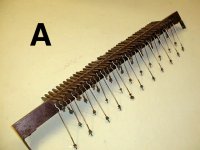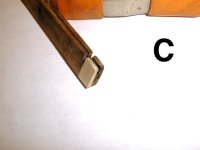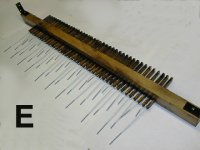
TANGLEY CALLIOPE RESTORATION PROJECT (part 26)
by Dr. Bill BlackRESTORING THE KEYBOARD TO THE STACK LINKAGE
Now that the pneumatic stack is installed we can see that the operating motion of the stack pneumatics when they collapse is in an upward direction. The direction of motion of the keys on the keyboard is of course a downward direction. So, we need some mechanism to connect the stack pneumatics to the keyboard. This is accomplished by a mechanism we will call the stack linkage.

PHOTO A shows this unrestored linkage. It consists of wooden fingers with a long rod running through the center of each finger. When the one end of the finger moves downward the other end moves in the opposite direction. The long rod is enclosed in a groove in the wood strip which supports the whole arrangement. This linkage was rather oily since it located close to the pressure exhaust valve on the pressure tank. The Roots blower likes to put out a bit of oil mist during itıs operation and some of this ends up on the linkage.

Over the years, part of the end of the finger which is connected to the rod to the keyboard has a tendency to break off if the rod is removed often. In order to use these fingers again it was necessary to repair a few of them. This was done by using a milling machine to cut a channel back to solid wood so we can glue on a new piece of wood to repair the broken side on the end (PHOTO B).
PHOTO C shows then repaired end. (it is upside down in the photo). The groove in the end retains the end of the rod to the keyboard and is held in place with a piece spring wire. Since most of the force applied to the finger is in a vertical direction, the repaired piece of the side is not subjected to a lot of stress.
PHOTO D shows the repaired fingers and the wooden rail which they are mounted in cleaned and ready for a shellac finish and reassembly.
PHOTO E shows the completed linkage mechanism finished and ready to be installed in the calliope. The rods shown in the picture will be connected to the wooden fingers on the stack pneumatics with leather nuts. These rods were cleaned and painted with silver paint.

The ends of wooden rail are attached to the sides of the calliope with metal brackets. In PHOTO F, the linkage has been installed in the calliope. The rods which connect the one end of the wooden fingers to the stack pneumatics have been installed and fastened to the pneumatic fingers with leather nuts. The other end of the wooden fingers will be attached to the rods going to the keyboard later.
Dr. Bill Black is one of the nation's most knowledgeble Wurlitzer band organ experts. He has made recordings of many band organs and other mechanical music machines which are available for purchase in our CarouselStores.com website.